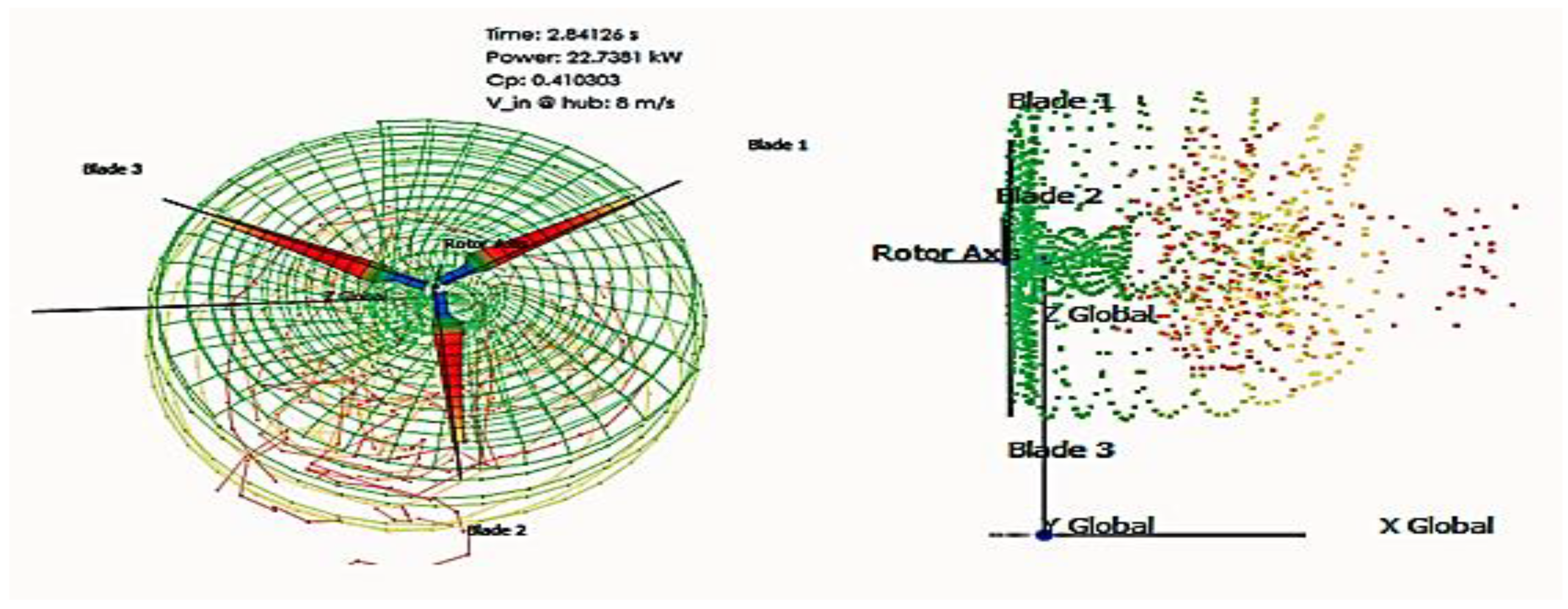Design and Airflow Analysis of 20 kW Horizontal Axis Wind Turbine Blade †
Abstract
1. Introduction
2. Design Parameters
3. Results and Discussion
4. Airfoil
4.1. Foil Specifications
4.2. Static Structural Analysis
4.3. Airflow Analysis
5. Conclusions
Author Contributions
Funding
Informed Consent Statement
Data Availability Statement
Acknowledgments
Conflicts of Interest
References
- Chougule, P.; Nielsen, S. Overview and Design of Self-Acting Pitch Control Mechanism for Vertical Axis Wind Turbine Using Multi-Body Simulation Approach. J. Phys. Conf. Ser. 2014, 524, 012055. [Google Scholar] [CrossRef]
- Khan, S.; Shah, K.; Izhar-Ul-Haq; Khan, H.; Ali, S.; Ahmad, N.; Abid, M.; Ali, H.; Ihsanullah; Sher, M. Observation of the Starting and Low Speed Behavior of Small Horizontal Axis Wind Turbine. J. Wind Energy 2014, 2014, 527198. [Google Scholar] [CrossRef]
- Porté-Agel, F.; Bastankhah, M.; Shamsoddin, S. Wind-Turbine and Wind-Farm Flows: A Review. Bound. Layer Meteorol. 2020, 174, 1–59. [Google Scholar] [CrossRef]
- Siddique, S.; Wazir, R. A Review of the Wind Power Developments in Pakistan. Renew. Sustain. Energy Rev. 2016, 57, 351–361. [Google Scholar] [CrossRef]
- Ghafoor, A.; ur Rehman, T.; Munir, A.; Ahmad, M.; Iqbal, M. Current Status and Overview of Renewable Energy Potential in Pakistan for Continuous Energy Sustainability. Renew. Sustain. Energy Rev. 2016, 60, 1332–1342. [Google Scholar] [CrossRef]
- Abbas, Z.; Abbas, S.; Butt, Z.; Pasha, R.A. Design and Parametric Investigation of Horizontal Axis Wind Turbine. J. Shanghai Jiaotong Univ. (Sci.) 2018, 23, 345–351. [Google Scholar] [CrossRef]
- Lanzafame, R.; Messina, M. Horizontal Axis Wind Turbine Working at Maximum Power Coefficient Continuously. Renew. Energy 2010, 35, 301–306. [Google Scholar] [CrossRef]
- Baloch, M.H.; Kaloi, G.S.; Memon, Z.A. Current Scenario of the Wind Energy in Pakistan Challenges and Future Perspectives: A Case Study. Energy Rep. 2016, 2, 201–210. [Google Scholar] [CrossRef]
- Sohoni, V.; Gupta, S.C.; Nema, R.K. A Critical Review on Wind Turbine Power Curve Modelling Techniques and Their Applications in Wind Based Energy Systems. J. Energy 2016, 2016, 8519785. [Google Scholar] [CrossRef]
- Osei, E.Y.; Opoku, R.; Sunnu, A.K.; Adaramola, M.S. Development of High-Performance Airfoils for Application in Small Wind Turbine Power Generation. J. Energy 2020, 2020, 9710189. [Google Scholar] [CrossRef]




| Blade Length (l) | Tower Height (h) | Swept Area (A) | Rotor Diameter (d) | Rotor Speed | Number of Blades (n) |
|---|---|---|---|---|---|
| 7.2 m | 40 m | 6.92 m | 89.66 rpm | 3 |
| Wind Speed (m/s) | CP | Output Power (kW) | |
|---|---|---|---|
| 9.2 | |||
| 8.67 | |||
| 8.12 |
Publisher’s Note: MDPI stays neutral with regard to jurisdictional claims in published maps and institutional affiliations. |
© 2022 by the authors. Licensee MDPI, Basel, Switzerland. This article is an open access article distributed under the terms and conditions of the Creative Commons Attribution (CC BY) license (https://creativecommons.org/licenses/by/4.0/).
Share and Cite
Hamza, M.; Ali, A.; Abbas, S.; Abbas, Z. Design and Airflow Analysis of 20 kW Horizontal Axis Wind Turbine Blade. Eng. Proc. 2022, 23, 11. https://doi.org/10.3390/engproc2022023011
Hamza M, Ali A, Abbas S, Abbas Z. Design and Airflow Analysis of 20 kW Horizontal Axis Wind Turbine Blade. Engineering Proceedings. 2022; 23(1):11. https://doi.org/10.3390/engproc2022023011
Chicago/Turabian StyleHamza, Muhammad, Ahmad Ali, Saqlain Abbas, and Zulkarnain Abbas. 2022. "Design and Airflow Analysis of 20 kW Horizontal Axis Wind Turbine Blade" Engineering Proceedings 23, no. 1: 11. https://doi.org/10.3390/engproc2022023011
APA StyleHamza, M., Ali, A., Abbas, S., & Abbas, Z. (2022). Design and Airflow Analysis of 20 kW Horizontal Axis Wind Turbine Blade. Engineering Proceedings, 23(1), 11. https://doi.org/10.3390/engproc2022023011






